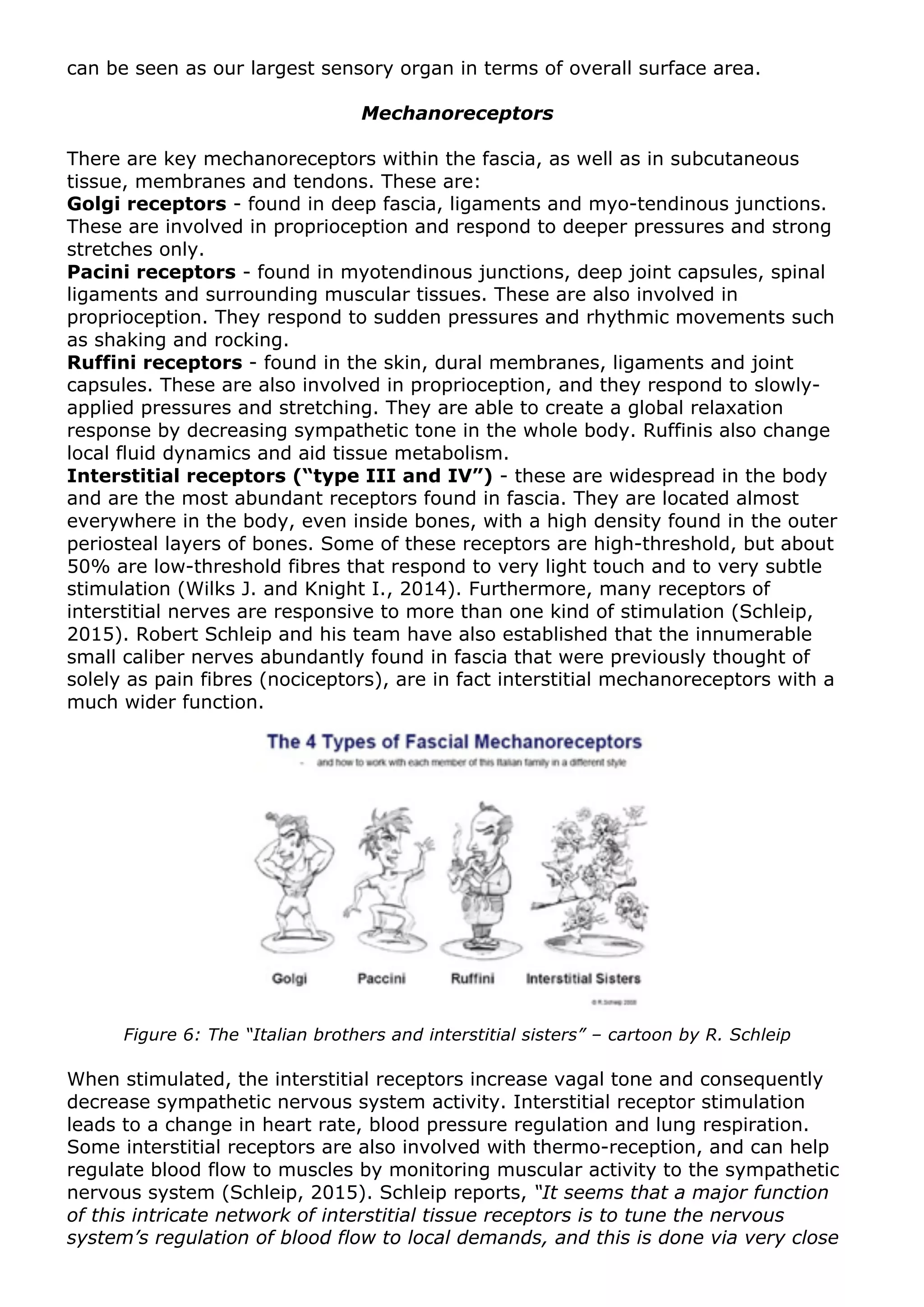The document discusses the significance of fascia, previously overlooked in anatomy, as a vital and complex tissue that plays crucial roles in bodily functioning, communication, and movement. Recent discoveries reveal fascia as a liquid crystalline matrix that connects all body structures, facilitates internal communication, and can influence health through its hydration and elasticity. The study highlights the interconnectedness of fascia with the nervous system and its role in maintaining overall homeostasis through a tensegrity structure.



![electrical charge, which is considered important for healthy biological systems
(Pollack, 2001). Much pathology, such as inflammatory conditions or the
accumulation of waste products, tends to go along with a shift towards a higher
percentage of bulk water within the ground substance.
Fascial hydration generally decreases with under-use and in old age. Deane Juhan
describes dehydrated and stuck fascial tissues as “thixotrophic” (Juhan, 2002).
Indications by Sommer and Zhu (2008) suggest that when fascia gets squeezed
like a sponge and subsequently rehydrated during exercise, some of the previous
bulk water zones may then be replaced by bound water molecules. Dr. Still
observed, “This connecting substance [fascia] must be free at all parts to receive
and discharge all fluids, and use them in sustaining animal life, and eject all
impurities, that health may not be impaired by dead and poisonous fluids” (A.T.
Still, 1902).
In Craniosacral practice, we work with the intimate relationship between fluid and
potency. Potency loves fluid and vice versa - where one goes, so does the other!
We know that fluid acts as the carrier of life, but it’s also found that the expression
of potency within the body directly influences fluid dynamics. Fluid re-hydration
naturally occurs when potency is re-established. Therefore, if we are able to
facilitate the expression of potency in the body (e.g. by resolving inertial fulcra or
augmenting primary respiration), the tissues can naturally re-hydrate.
Fascia As A Communication System
Fascia is seen as a communication system for whole the body (Oschman, 2012;
Ho and Knight, 1998). Dr. Mae Wan Ho describes this liquid-crystalline matrix as
being highly responsive to electrical charge, and also able to carry impulses very
fast. She suggests that impulses created in the fascia are amplified via the action
of proteins in the liquid crystal.
The collagen fibres in fascia have been described as the conductor of electrons in
the body, whilst the ground substance is the reservoir of electrons (Oschman,
2008). Dr. Zvi Karni, a professor of Biological Engineering in Israel, has also
demonstrated that fascia is able to conduct electricity, so helping to transmit
energy throughout the body and act as a carrier of information (Upledger and
Vredevoogd, 1983). Furthermore, the collagen fibres can transmit photons (light)
and have been measured to have piezoelectric properties (the ability to generate
an electric charge in response to applied pressure). The collagen fibres can be
thought of as “fibre optics” for the body, in which impulses can be created by very
light pressures. The conductivity of collagen is dependent on how hydrated it is;
the more hydrated, the more impulses can flow freely through the fascia.
Herbert Frohlich (1968) and Fritz Popp (2003), have demonstrated that living cells
emit light (photons) across a wide variety of wavelengths and that this is an
important way in which cells communicate with each other. According to Dr. Will
Wilson, “In cancer the output of light is much reduced, thereby reducing the
potential for cell-to-cell communication. Cancer cells act as if out of touch with the
rest of the organism, proliferating uncontrollably. So, for cellular health it seems
likely that a light-based communication system is needed”. Dr. Sutherland talked
about liquid light and transmutation, so perhaps he was describing from
observation what science is now starting to explain in the language of biology
(Ukleja, 2012).](https://image.slidesharecdn.com/thelivingmatrix-article-190408102415/75/The-Living-Matrix-4-2048.jpg)








![Still A.T. (1899) Philosophy of Osteopathy. Re-printed 2014: CreateSpace Independent Publishing
Platform.
Still A.T. (1902) The philosophy and mechanical principles of osteopathy. Hudson-Kimberly
Publishing Company, Kansas City, 61-62.
Thomas F. and Robet S. (2009), “Introduction,” in Fascia Research II, Amsterdam Basic Science
and Implications for Conventional and Complementary Health Care, p.7, Elsevier Press,
Amsterdam.
Ukleja K (2012) Fascia - new directions. Unpublished article and class notes at Craniosacral
Therapy Educational Trust.
Upledger J. and Vredevoogd J. (1983), Craniosacral Therapy. Eastland Press 236
van der Wal J.C. (2009) The Architecture of Connective Tissue as a Functional Substrate for
Proprioception in the Locomotor System. Amsterdam: Second International Fascia Research
Congress.
van der Wal J.C. (1988) The organisation of the substrate of proprioception in the elbow region of
the rat. [PhD thesis]. Maastricht University, Faculty of Medicine.
Wilks J. and Knight I. (2014) Using The Bowen Technique. Singing Dragon.
© Michael Kern 2015](https://image.slidesharecdn.com/thelivingmatrix-article-190408102415/75/The-Living-Matrix-13-2048.jpg)